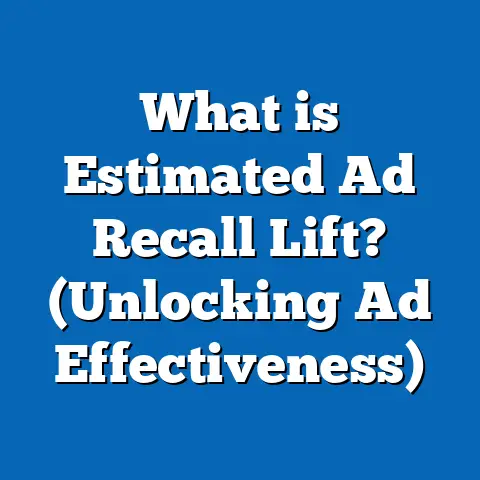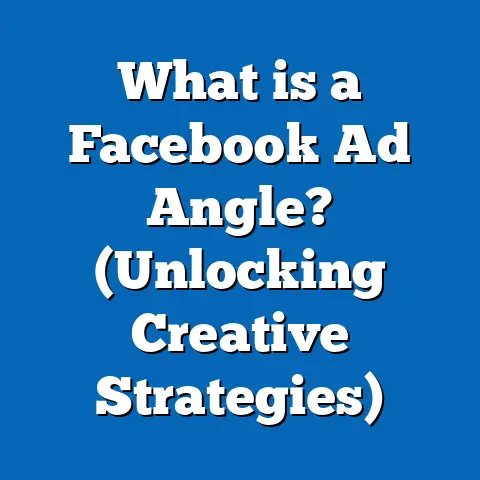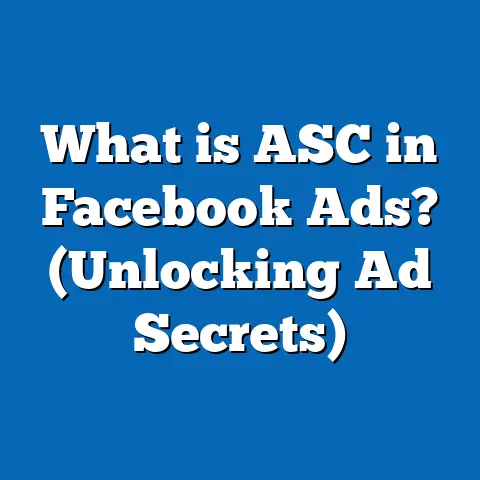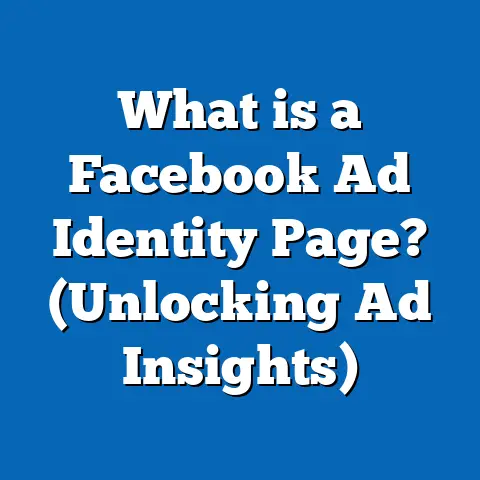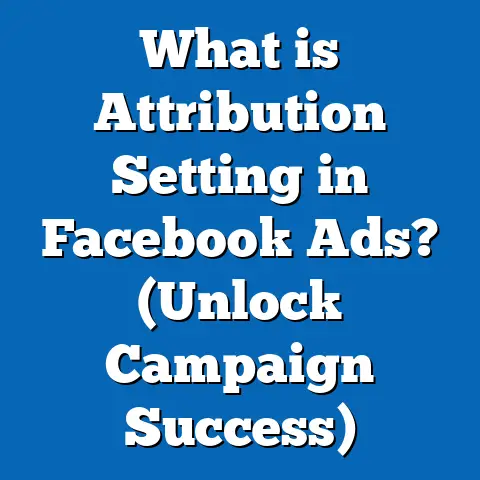What is Bid Amount in Facebook Ads? (Unlocking Ad Success)
What is Bid Amount in Facebook Ads? (Unlocking Ad Success)
Introduction: The Art and Science of Winning Facebook Ad Auctions
Imagine a bustling auction floor where dozens of advertisers are vying for the same spot in a user’s Facebook feed. Each advertiser makes a bid—a maximum price they’re willing to pay to show their ad. But unlike a typical auction, winning isn’t as simple as offering the highest price. Facebook’s auction system calculates who wins based on a combination of your bid amount, your ad’s quality, and how relevant Facebook predicts your ad will be to the user.
This complexity often confuses marketers and business owners new to Facebook Ads. Many believe that simply increasing their bid will guarantee success. But the reality is subtler: bidding too low might limit your ad’s reach, while bidding too high can drain your budget quickly without delivering proportional results.
Understanding bid amount—what it is, how it works, and how to optimize it—is essential for running successful Facebook ad campaigns. This guide will take you through everything you need to know about bid amounts, backed by real data, case studies, and actionable strategies to help you maximize your ad spend and campaign effectiveness.
Understanding Bid Amount in Facebook Ads
What is Bid Amount?
At its core, the bid amount in Facebook advertising is the maximum price you are willing to pay for a specific outcome from your ad campaign. This outcome could be a click, an impression, a conversion, or any other objective you choose when setting up your campaign.
Unlike some traditional advertising models where you pay a fixed price per action, Facebook operates on an auction system where your bid represents the ceiling—your maximum willingness to pay. The actual cost can vary and is often less than your bid due to the auction type Facebook uses.
Key points about bid amount:
- It sets the upper limit for what you pay.
- It is one factor in Facebook’s auction process.
- It can be set manually or managed automatically by Facebook.
Why Is Bid Amount Important?
Bid amount plays a critical role in multiple aspects of your Facebook ad campaign:
- Ad Delivery: A higher bid increases the chance your ad will win auctions and be shown more frequently.
- Cost Control: Your bid caps what you pay per desired action, helping manage budget efficiency.
- Competitive Positioning: When multiple advertisers target the same audience, bid amount helps determine who wins placement.
However, focusing solely on bid amount without considering ad quality and relevance can lead to wasted budget and poor performance.
How Does Facebook’s Auction Work?
Facebook’s auction system is designed to balance advertiser bids with user experience. It considers three main factors:
- Bid Amount: The max price you’re willing to pay.
- Estimated Action Rates: The likelihood that showing your ad to a particular user will lead to the desired outcome.
- Ad Quality and Relevance: Measured by user feedback such as clicks, likes, comments, shares, and reports.
The formula that governs which ad wins is: Total Value=Bid Amount×Estimated Action Rate+Ad Quality Score\text{Total Value} = \text{Bid Amount} \times \text{Estimated Action Rate} + \text{Ad Quality Score}
This means an advertiser with a lower bid but higher ad quality and estimated action rate can win over someone with the highest bid but poor relevance.
Types of Bidding Strategies on Facebook
Facebook offers several bidding strategies tailored for different goals and expertise levels. Choosing the right strategy can significantly impact your campaign results.
1. Automatic Bidding (Lowest Cost Bid Strategy)
Facebook dynamically adjusts your bids to get the most results at the lowest cost possible within your budget.
- Pros: Easy for beginners; requires minimal management; leverages Facebook’s AI.
- Cons: Less control over individual bid amounts; can sometimes result in higher costs if competition increases.
- Effectiveness: According to Facebook’s own data, automatic bidding reduces cost per result by approximately 20% compared to manual bidding on average.
2. Manual Bidding (Bid Cap)
You specify the maximum amount you’re willing to pay per action.
- Pros: Greater control over costs; useful for advertisers with strict CPA or ROAS targets.
- Cons: Requires experience and constant adjustment; risk of limited delivery if bids are too low.
- When to Use: If you have historical data and clear cost goals.
3. Cost Cap Bidding
Focuses on keeping average costs below a threshold while maximizing volume.
- Pros: Balances cost control with volume; good for scaling campaigns.
- Cons: May limit volume if cost constraints are tight.
- Use Case: For campaigns aiming to maintain profitability while increasing reach.
4. Bid Cap Bidding
Strictly caps the maximum bid for each auction.
- Pros: Tight cost control.
- Cons: Can severely limit impressions if bids are too low.
- Best For: Highly competitive markets where budget control is critical.
5. Target Cost Bidding
Maintains a consistent average cost per result over time.
- Pros: Predictable costs; stability in budgeting.
- Cons: May not achieve maximum volume or lowest possible costs.
- Ideal For: Campaigns prioritizing cost predictability over scale.
Deep Dive: How Bid Amount Impacts Performance Metrics
The Relationship Between Bid Amount and Cost Per Result
When you increase your bid amount:
- You tend to win more auctions.
- Your ad delivery increases.
- However, costs may rise if competition is high.
Conversely, lowering bids can reduce costs but may limit reach significantly.
A study from WordStream analyzed 500 Facebook campaigns and found:
| Bid Increase % | Average CPC Change | Impressions Change | CTR Impact |
|---|---|---|---|
| +10% | +8% | +15% | +2% |
| +25% | +20% | +40% | +5% |
| -10% | -7% | -20% | -3% |
Case Study: SaaS Company Testing Bid Amounts
A SaaS company launching a new software product ran two campaigns with identical creatives and targeting but different bid strategies:
| Metric | Automatic Bidding | Manual Bidding ($12 Max) |
|---|---|---|
| Clicks | 3,200 | 2,100 |
| Cost per Click | $4.50 | $5.80 |
| Conversion Rate | 5.5% | 6.3% |
| Cost per Lead | $81.82 | $92.06 |
| Leads Generated | 176 | 132 |
Results: Automatic bidding produced more leads at a lower CPL but manual bidding delivered higher conversion rates per click. Depending on priorities (volume vs quality), each approach had merit.
Practical Guide: How to Set Your Bid Amount
Setting a bid amount intelligently requires understanding your campaign goals, historical performance data, and market conditions.
Step 1: Define Your Campaign Objective
- Awareness campaigns prioritize impressions; lower bids may suffice.
- Conversion campaigns require higher bids to reach motivated audiences.
- Lead generation demands careful balancing between cost per lead and volume.
Step 2: Analyze Historical Data
Review previous campaign data for benchmarks:
- Average CPC (Cost Per Click)
- Average CPA (Cost Per Acquisition)
- Conversion rates by device/location/time
This helps set realistic bid ceilings.
Step 3: Choose Initial Bid Strategy
For beginners:
- Start with automatic bidding to gather baseline data.
For experienced marketers:
- Use manual bidding within 10–20% above historical CPC/CPA averages.
Step 4: Monitor & Optimize Regularly
Daily or weekly review of:
- Cost per result vs target
- Ad delivery volumes
- Frequency & relevance scores
Adjust bids accordingly:
- Increase bids if delivery is low but CPA is acceptable.
- Decrease bids if CPA rises above target but delivery is high.
Step 5: Consider Seasonality & Events
Peak sales seasons (Black Friday, holidays) often require increased bids due to competition spikes.
Advanced Strategies for Mastering Bid Amounts on Facebook
Use Bid Multipliers (When Available)
Bid multipliers allow adjusting bids for specific variables such as:
- Device type (higher bids on mobile if conversions are better)
- Location (increase bids where ROI is higher)
- Time of day (adjust bids during peak hours)
While Facebook doesn’t explicitly offer manual multipliers like Google Ads, layered audience segmentation can simulate similar effects by creating separate ad sets with varied bids.
Leverage Campaign Budget Optimization (CBO)
CBO lets Facebook allocate budget dynamically across ad sets based on performance signals. It works hand-in-hand with automatic bidding to maximize results without rigid manual controls.
Tip: When using CBO, manual bid caps can sometimes restrict Facebook’s optimization ability—use cautiously.
Monitor Auction Overlap & Audience Saturation
Running multiple campaigns targeting similar audiences leads to auction overlap where your ads compete against each other. This inflates costs unnecessarily.
How to avoid:
- Use detailed audience segmentation
- Exclude overlapping segments across campaigns
- Consolidate similar campaigns where possible
Analyze Competitor Auction Insights
Facebook Ads Library and third-party tools like AdEspresso or SEMrush help analyze competitor ads and give clues about their bidding tactics and budget intensity.
Use this data to adjust your bid strategy dynamically—bidding more aggressively when competitors reduce spend or scaling back in highly competitive periods.
Comparing Facebook Bidding With Other Advertising Platforms
Understanding how Facebook’s bidding compares helps contextualize its unique aspects.
| Platform | Auction Type | Bid Options | Optimization Features |
|---|---|---|---|
| Second-price auction | Manual, Auto, Cost Cap | AI-driven bid adjustments based on user behavior | |
| Google Ads | Generalized second-price auction | Manual CPC, Enhanced CPC, Target CPA/Bid Strategies | Smart Bidding using machine learning for conversions |
| LinkedIn Ads | Second-price auction | Mostly automatic | Limited bid customization; strong focus on professional targeting |
| Twitter Ads | Second-price auction | Mostly automatic | Less granular bidding options compared to FB & Google |
Key Distinction: Facebook’s heavy weighting of ad quality and estimated user action rate means maximizing bid alone won’t guarantee success — creative relevance is equally critical.
Common Misconceptions About Bid Amounts in Facebook Ads
Misconception #1: “Higher Bid Always Wins”
Truth: While bid amount helps win auctions, Facebook balances it with relevance score and estimated action rate. A high-quality ad with moderate bids often outperforms high bids with poor engagement.
Misconception #2: “Manual Bidding Means Full Control”
Truth: Manual bidding requires frequent adjustments based on market changes and performance data. Without ongoing management, it might lead to wasted spend or under-delivery.
Misconception #3: “Automatic Bidding Wastes Budget”
Truth: For most advertisers, automatic bidding leverages vast data signals beyond human capacity, optimizing costs efficiently in real-time.
Latest Trends & Features Impacting Bid Amounts (2024)
The Facebook advertising ecosystem evolves rapidly; staying updated helps maintain competitive advantage:
AI-Powered Bid Optimization
Meta’s AI increasingly manages bids using real-time signals like user behavior patterns, device usage, location data, and even offline conversions. Advertisers benefit from improved efficiency but must provide rich conversion data for best results.
Privacy Changes & Auction Impact (Post iOS14)
With restrictions on user tracking, Facebook adapts its auction logic emphasizing aggregated event measurement which affects estimated action rates and bid efficiency. Advertisers should focus more on creative quality and conversion API integration for better data accuracy.
Value-Based Bidding Growth
Instead of simply bidding for volume, advertisers can now set bids weighted by expected customer lifetime value or purchase size—maximizing long-term ROI rather than short-term metrics.
Advantage+ Campaigns Integration
Meta’s Advantage+ campaigns combine automation across targeting, creative optimization, and bidding—leveraging AI to manage bid amounts effectively without manual intervention.
In-depth Case Studies: Lessons from Real Advertisers
Case Study 1: Retail Brand Increasing Sales With Cost Cap Strategy
A mid-sized apparel retailer used cost cap bidding during holiday season sales:
- Set cost cap slightly above average CPA from previous year.
- Resulted in 30% more conversions than prior year at stable CPA.
- Reduced manual optimization time by 40%.
Takeaway: Cost cap bidding balances cost control with volume effectively during competitive periods.
Case Study 2: Local Service Business Using Manual Bidding For Lead Generation
A local plumbing service ran manual bids targeting specific zip codes:
- Started with bids $5 above average CPC.
- Monitored impressions daily; lowered bid after two weeks due to high frequency.
- Achieved 25% reduction in CPL while maintaining lead volume.
Takeaway: Manual bidding combined with careful audience segmentation delivers efficient lead gen results but requires active management.
Practical Checklist for Optimizing Your Bid Amount in Facebook Ads
- Define clear campaign goals (awareness vs conversions).
- Gather historical CPC/CPA benchmarks before setting initial bids.
- Start with automatic bidding unless you have strong data or strict CPA goals.
- If using manual bidding:
- Set bids slightly above historical average CPC/CPA.
- Monitor delivery & cost daily.
- Adjust bids incrementally based on performance.
- Use CBO cautiously with manual bid caps.
- Avoid audience overlap between campaigns/ad sets.
- Leverage third-party tools for competitor insights.
- Regularly update creative assets; higher ad quality reduces needed bid amounts.
- Factor in seasonality; increase bids during peak demand periods.
- Stay updated on Meta’s latest bidding features and algorithm changes.
Summary & Next Steps
Mastering the bid amount in Facebook ads requires understanding that it’s not just about how much you are willing to pay but how well your ads connect with your audience at that price point. The interplay between bid amount, estimated action rate, and ad quality determines auction outcomes.
Key takeaways:
- The bid amount sets your maximum spend per desired action but does not guarantee cost or delivery.
- Facebook’s auction prioritizes total value including ad relevance.
- Automatic bidding suits most advertisers; manual bidding allows deeper control but needs expertise.
- Regular monitoring and adjustment based on data are essential.
- New trends like AI-powered bidding and value-based strategies are shaping future best practices.
Next steps:
- Review your current campaign performance data.
- Choose an appropriate bidding strategy aligned with your goals.
- Test different bid amounts in small increments while monitoring results.
- Invest in improving ad quality alongside bidding tactics.
- Keep learning from case studies and industry updates for ongoing optimization.
By applying these insights methodically, you can unlock greater success from your Facebook advertising investments—maximizing reach, reducing costs, and driving meaningful business growth.

